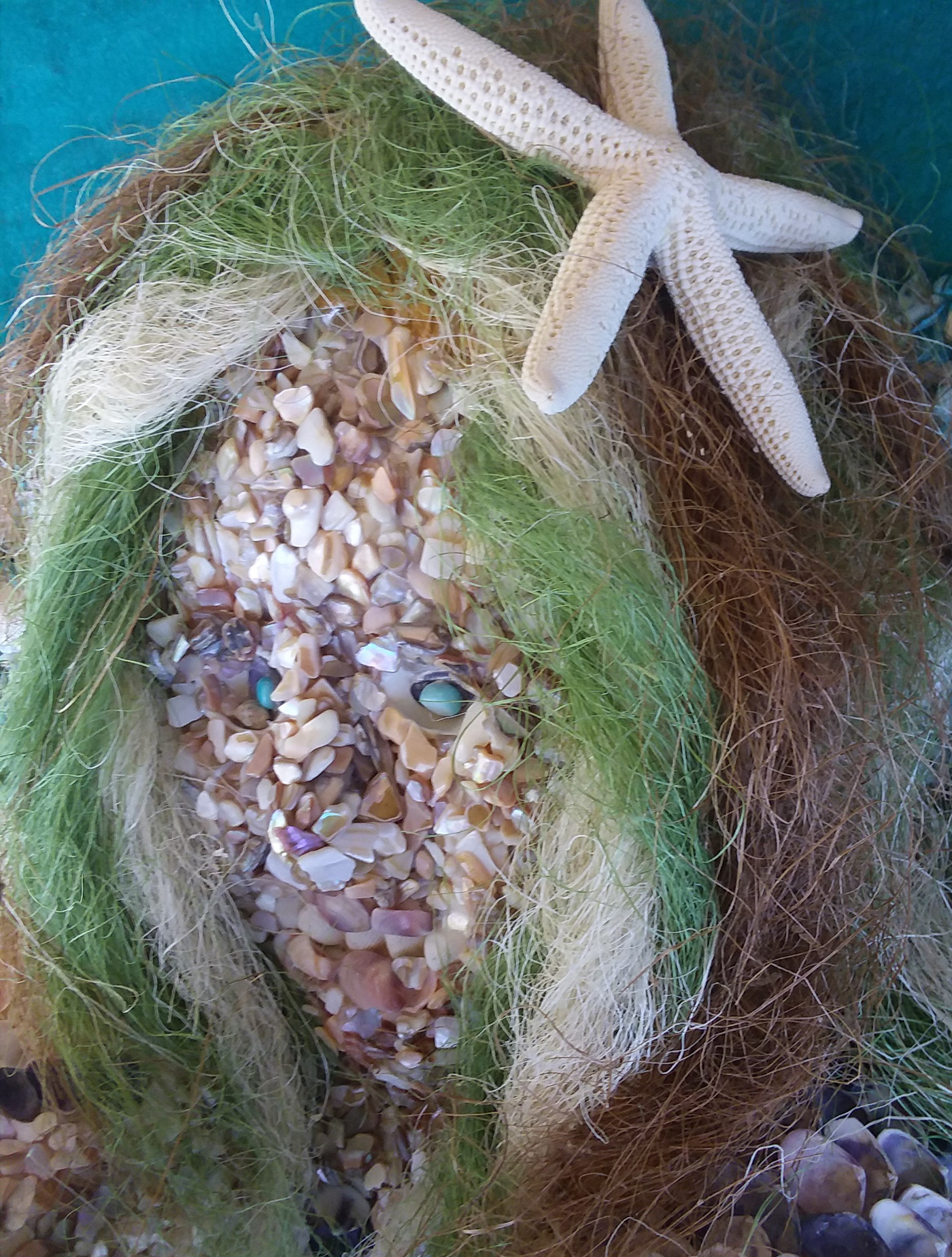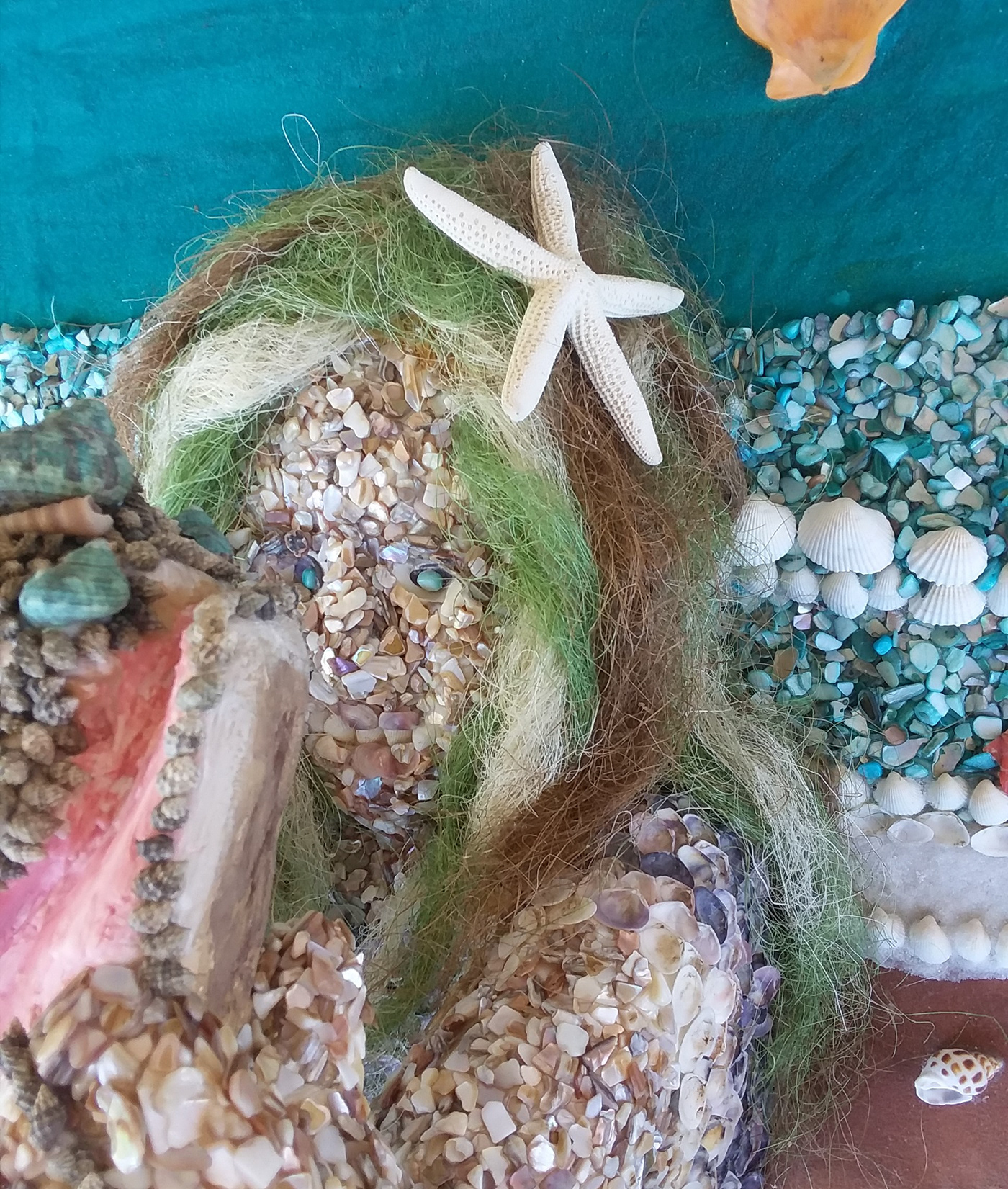Materials Workshop: Through this workshop I stepped out of my comfort zone and experimented with a variety of materials. I learned to consider canvas's and materials to support the concept of my work. Through considering textures and experimentation on effects of combining materials I am more aware of how to implement concepts in a variety of ways. I thought I was a painter, but now I consider myself more of a multi-media artist because of this workshop specifically. Texture is my new passion! However, I did learn that they do not stand alone and often need a drawing element in the work. I began to notice that I am drawn to natural materials or materials that express an appreciation of nature. I also began to see that my works were intentional towards specific audiences, for a specific use.

Materials Assignment #1: Marking Your Territory
Make an abstract image of a chosen space with elements that are within the space. Use elements in the space to make your marks on bristol paper.
Title: Front Porch Garden in Winter

Marking Your Territory: sketch of front garden in winter with scientific plant names, collected dried, dead plant pieces to paint with, and salt for sidewalk
Materials: dried plants, pickeling salt, watercolor paint, watercolor resist removable adhesive, oil pastels

Method: Painting with a dried Blanket Flower , Oil Pastel Markings on Watercolor Paper, Water Color Resist Removable Adhesive

Close Up: Pips from the "Burning Bush" were collected as a three-dimensional element of the work. Scientific names written with common name in my own handwriting in ink. Oil pastel representation of bush branches and negative white space representative of snow on the bush. Use of water color and salt, like salt on the sidewalk, to capture the colors of winter.

Method: Twigs and pine needles from the Spruce tree were used to brush on paint colors over the watercolor resist adhesive. After the adhesive was removed it represents the white of the snow on the evergreen branches.


Method: The dried twigs and flower stems used to paint became part of the piece when it was adhered into the dried paint. Using the dried blanket flower twig and sedum twig added a more textured, splotchy effect in the paint which I found lent itself to the piece.

Experimentation painting Samantha with a variety of found objects:
cotton ball and ink

push pin and ink

feather and ink

rocks and ink

Materials Assignment # 2: Materials Exploration
Above: Tangerine Peels and tangerine oil, This effect was more sensory through touch and smell than visual.

Material: Homemade Rootbeer and ink with a variety of experimentation techniques.

Materials: Homemade Goat Milk Soap (made by myself from my own pet goats), blue watercolor
You can see the faint outline of "Homemade Goat Soap" written with the bar of soap then painted over at the top of the page.

Bubbles were removed from the brush with a twisting motion and allowed to dry, leaving a space still resembling the bubble where it had popped.

Materials Assignment #2: 3 Nontraditional Materials and a Grid Pattern
Title: The Great Salt Lake Area

Materials Exploration to find an interesting effect for land with canola oil, tumeric, paprika and crayon with brown watercolor.

Materials Exploration to find an interesting effect for land with rock salt, peroxide,and baking soda with brown watercolor.

Materials Exploration to find an interesting effect for land withn alcohol second, alcohol first, sugar frist, sugar second and using a baster brush with brown watercolor.

Experimental Materials: Acrylic with paste, peroxide, painted with: a dried rose, sea sponge, painters knife, feather, crumpled tinfoil

Modeling paste and acrylic, salt, and bubbles add contrasting textures that give the piece interest. I'd like to redo this work without the writing.

Materials: Watercolor, peroxide, salt, goat soap bubbles, acrylic paint, acrylic modeling paste, ink

Acrylic with modeling paste to add texture to the mountainous landscape

Materials Assignment #3: 3 Non-traditonal Surfaces or Materials on a Non-traditional Canvas with an Inset Drawing
Title: Barn Painting, A day out plein air painting with my kids

Non Traditional Surfaces or Materials: Barnwood, Acrylic Gel Medium Image Transfers in black and white and color, Canvas removed from frame and torn

Inset Drawing: extension of barn in white pencil, black chalk, white chalk

The barn painting that I actually painted that day on torn canvas, gel medium transferred images of us on an outing painting the barn, and the easel that I used to paint the barn painting used for display. The barn roof is a repititious pattern through out the piece.

Non-traditional Materials: Mossy wood, rusty hinges, dried lavendar sprigs
Final Project Proposal: She Sells Sea Shells
I propose to do a muti-materials scultpure, She Sells Sea Shells, as my final Materials project. This will add to an existing body of works based on tongue twisters. The child-like materials of the works are geared towards an elementary school mini-artshow setting in which the artwork relates to a tongue twister. The mediums of sand, sea shells, broken colored seashell pieces and grasses lend themselves playfully to the seashore. The use of craft sand, glue, grasses and seashells are recognizable materials for the elementary school age child. Through the process of searching for which tongue twister this art project may represent the children will explore the materials used more carefully to find meaning in the work. This provides scaffolding that will lead them to exploring other works with more subtle materials to find meanings in those works. By realizing that they can better understand artworks when they know more about the world around them, this concept will relate to more advanced works and increase a sense of curiosity and exploration in future opportuntities for them to view art.

Materials: Fiberboard, Styrofoam, foam glue, wooden dowels, wood glue
Subtractive Method: Carving foam pieces
Additive Method: Stacking carved wooden pieces over dowels for depth

Materials: Drywall Joint Compound layer
Additive Method: Frosting the foam layers with compound and filling in any gaps where joints met

ethod: Drying time 2 -3 days for Joint Compound gave stregth and solidity to the piece

Materials: Blue Sea Shell Pieces, Scenic Sand, Sea Shells
Additive Method: Glueing on scenic sand, broken seashells for water, larger white seashells for waves, white sand for foam, brown sand for sand, and abalone shells in color arrangement for a textured approach to clothing. Orange shell added to represent the sun shining over the sandy sea.

Materials: brown seashell peices had to be glued on one at a time by hand due to the three demensional form
I loved the individuality of each shell and chose to leave the dirt from the sand in it for a more authentic, imperfect quality.

Materials: Acrylic Paint, Satin Acrylic Paint, Brown and Blue Sea Shell Pieces, Scenic Sand, Sea Shells
Method: Painting the inside of the conch shell with pink and white satin acrylic paint to give it a luster of an authentic seasheall, however, it is the least authentic aspect of this piece, since it is the shell that isn't made of shells, but other elements in the artwork are.


Finished conch seashell with added mini-spiral shells for enhanced line, texture and color. Additive seashells on top for spiral effect of a conch shell. This process was timely and painstaking due to the tendency for the pieces to slide off before drying on the three dimensional form.

Additive Process: Added three colors of grassy materials twisted together over an underpainting of ochre yellow acrylic paint. Starfish is glued over the top of a hidden shell glued directly to the head for stability and to raise it above the grassy hair.

Details: The lips are made of pink and purplish abolone shells over the top of smiling teeth of white grooved-line shells. The eyes are blue seashell pieces set inside a dark purple abolone shell, inside a white shell with darker shell pieces above to outline the eye area. There is a half formed pearl in the center of her forhead and the 3 colors of grasses are twisted into locks that fall on either side of her arms. Her hair has a distinct part in the center.

Changes in design: Originally I inteded for her to have a shelf under her arms and boards around the frame to represent a stand for selling seashells. However, barnwood proved ineffective due to the pieces shedding into the sand and sticking, making the piece appear dirty. I will decide between a twisted molding around the edges using new wood for a shelf structure, or another type of frame in the future.





